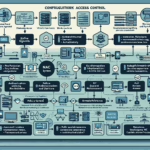Securing IT Infrastructure for IoT Devices: A Step-by-Step Enterprise Guide
The rapid adoption of IoT (Internet of Things) devices in enterprise environments has introduced new attack surfaces and security challenges. From manufacturing sensors to smart building systems, these endpoints often operate on minimal hardware, limited security features, and diverse protocols—making them prime targets for cyber threats. This guide provides a step-by-step, technically actionable framework to harden your IT infrastructure against IoT-related risks.
1. Conduct a Comprehensive IoT Asset Discovery
Before implementing security controls, you must know exactly what devices are connected.
Steps:
1. Use network scanning tools such as nmap or enterprise IoT discovery platforms like Armis or Cisco DNA Center.
2. Maintain a centralized asset inventory with device type, IP/MAC address, firmware version, and physical location.
3. Integrate asset data into your CMDB (Configuration Management Database) for automated change tracking.
Example Command:
bash
nmap -p 1-65535 --open --script banner -T4 192.168.10.0/24
This scans the subnet for active devices and attempts to identify services for profiling.
2. Network Segmentation and Zero Trust Architecture
IoT devices should never reside on the same VLAN or subnet as your critical business systems.
Best Practices:
– Create dedicated VLANs for IoT traffic.
– Implement micro-segmentation using SDN (Software Defined Networking) solutions like VMware NSX or Cisco ACI.
– Apply Zero Trust Network Access (ZTNA) policies: each device must authenticate before accessing services.
Example VLAN Segmentation (Cisco IOS):
bash
vlan 200
name IoT_Network
!
interface GigabitEthernet0/1
switchport mode access
switchport access vlan 200
spanning-tree portfast
3. Implement Strong Authentication and Device Identity Management
IoT devices often ship with default credentials—eliminate these immediately.
Steps:
1. Replace default usernames/passwords with unique credentials.
2. Use certificate-based authentication via an IoT PKI infrastructure.
3. Integrate 802.1X authentication for wired/wireless IoT access.
Example 802.1X Configuration (Linux Supplicant):
bash
network={
ssid="IoT_Secure_WLAN"
key_mgmt=WPA-EAP
eap=TLS
identity="device123"
ca_cert="/etc/ssl/certs/ca.pem"
client_cert="/etc/ssl/certs/device123.pem"
private_key="/etc/ssl/private/device123.key"
}
4. Patch Management and Secure Firmware Updates
Unpatched firmware is a common IoT vulnerability.
Best Practices:
– Schedule automated firmware scans to detect outdated versions.
– Use code-signing to verify firmware authenticity before deployment.
– Employ OTA (Over-The-Air) update mechanisms with encryption.
Firmware Validation Script Example (Bash + OpenSSL):
“`bash
!/bin/bash
FIRMWARE=”iot_device_fw.bin”
SIGNATURE=”iot_device_fw.sig”
PUBKEY=”vendor_pubkey.pem”
openssl dgst -sha256 -verify $PUBKEY -signature $SIGNATURE $FIRMWARE
if [ $? -eq 0 ]; then
echo “Firmware signature verified. Safe to install.”
else
echo “Firmware verification failed! Abort installation.”
fi
“`
5. Enforce Secure Communication Protocols
Avoid insecure protocols like Telnet or unencrypted HTTP.
Recommended Protocols:
– MQTT over TLS (mqtts://)
– CoAP over DTLS
– HTTPS with mutual TLS authentication
Example MQTT TLS Configuration (Python + Paho MQTT):
“`python
import paho.mqtt.client as mqtt
client = mqtt.Client()
client.tls_set(ca_certs=”ca.crt”,
certfile=”device.crt”,
keyfile=”device.key”)
client.connect(“mqtt.example.com”, 8883, 60)
client.publish(“iot/sensor/data”, “temperature=25.3”)
client.disconnect()
“`
6. Continuous Monitoring and Anomaly Detection
Deploy Security Information and Event Management (SIEM) tools to detect unusual IoT behavior.
Steps:
1. Integrate IoT logs into platforms like Splunk, Elastic Security, or Azure Sentinel.
2. Use AI-based anomaly detection to identify deviations in traffic patterns.
3. Apply real-time alerting for unauthorized access attempts.
Example Suricata Rule for IoT Traffic Monitoring:
txt
alert tcp any any -> 192.168.200.0/24 any (msg:"IoT VLAN Unauthorized Access Attempt"; sid:1000001; rev:1; threshold:type both, track by_src, count 5, seconds 60;)
7. Physical Security and Tamper Protection
IoT devices can be physically compromised.
Best Practices:
– Install devices in locked enclosures.
– Enable tamper detection sensors to trigger alerts.
– Disable all unused physical ports (USB, serial) via firmware settings.
8. Incident Response Plan for IoT Breaches
Assume that a breach will happen—plan for it.
Steps:
1. Define IoT-specific incident playbooks.
2. Create automated isolation workflows (e.g., via NAC or SDN).
3. Conduct quarterly IoT breach simulations to validate response readiness.
9. Compliance and Regulatory Alignment
Ensure your IoT infrastructure meets relevant compliance frameworks:
– NIST IoT Cybersecurity Framework
– ISO/IEC 27001
– GDPR for devices collecting personal data
Final Thoughts
Securing IoT infrastructure is not a one-time project—it requires continuous assessment, monitoring, and adaptation as threats evolve. By combining network segmentation, strong identity management, secure firmware practices, and AI-powered monitoring, enterprises can greatly reduce IoT-related risks while maintaining operational efficiency.
Tags: IoT Security, Network Segmentation, Zero Trust, Firmware Management, TLS, Enterprise IT, Cybersecurity Best Practices




